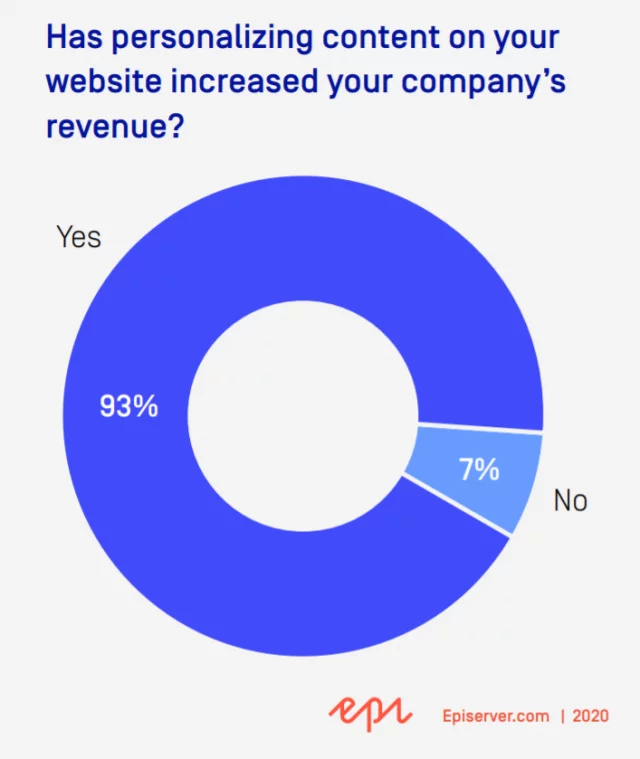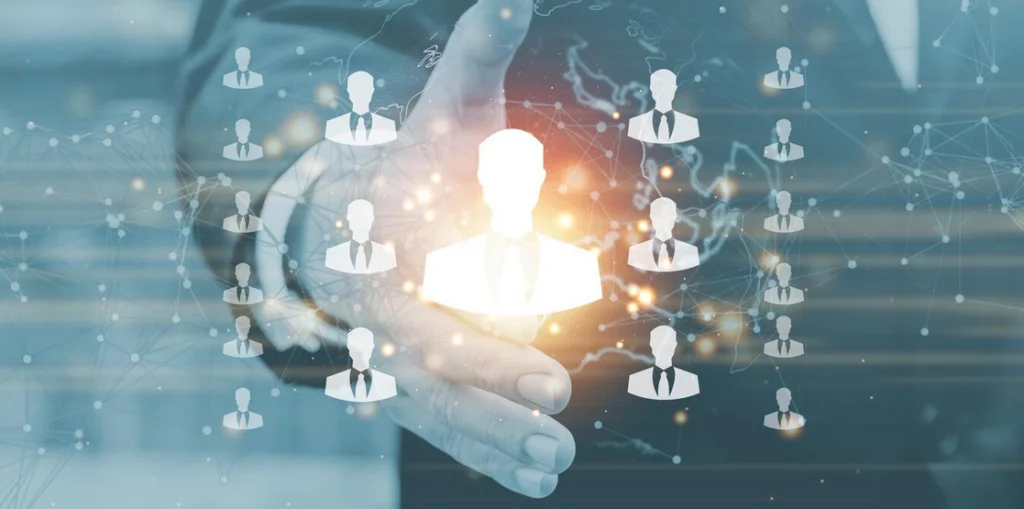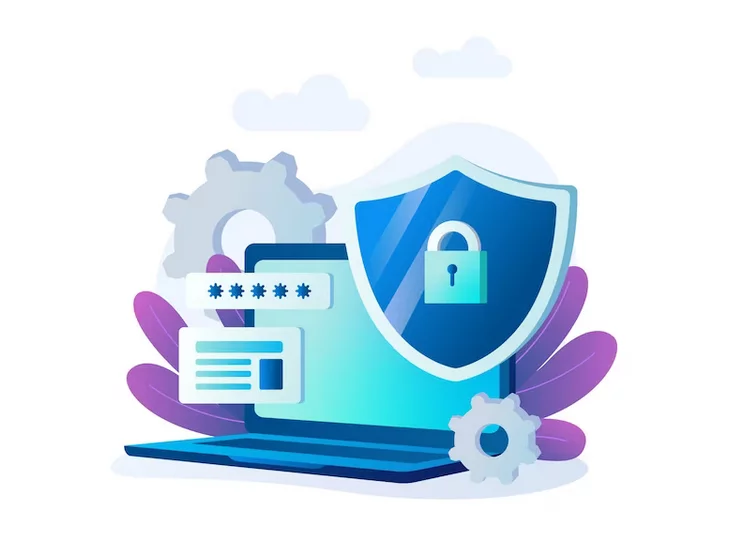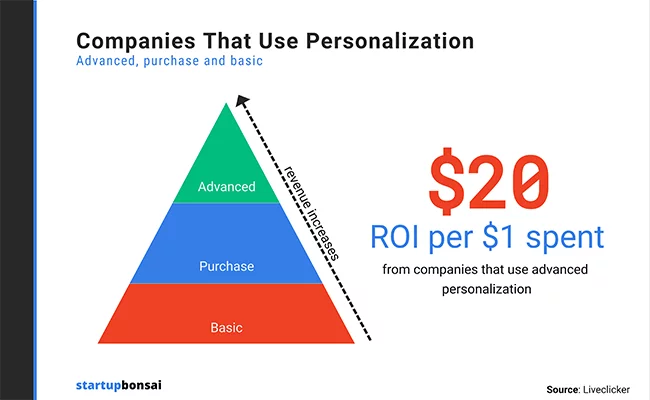In B2B transactions, the focus has traditionally been on functionality and efficiency. However, in today’s hyper-connected world, businesses are increasingly expecting personalized experiences akin to those found in the B2C sphere. This shift in expectation presents an opportunity for B2B websites to harness the power of personalization to create deeper connections, drive engagement, and ultimately elevate conversion rates.
Allow us to draw your attention to a fundamental truth articulated by Satya Nadella, CEO of Microsoft: “In a world of abundant computing power, the scarcest resource is human attention.” Nowhere is this truer than in the realm of B2B commerce. Amidst a flood of offerings, businesses aren’t merely seeking transactions; they’re craving bespoke experiences that cater to their unique demands.
Benefits of B2B Personalization:

Sourec: Komarketing
- Enhanced Customer Relationships: Personalization in B2B interactions allows for deeper and more meaningful relationships between businesses. Understanding the unique needs, preferences, and pain points of each business partner enables more effective communication and collaboration.
- Increased Customer Loyalty: Tailoring solutions and services to the specific requirements of B2B clients fosters loyalty. When businesses feel understood and supported, they are more likely to continue partnerships and even advocate for the service provider within their industry network.
- Improved Customer Retention: Personalization plays a crucial role in retaining B2B customers. By consistently delivering personalized experiences, services, and support, businesses can reduce churn rates and maintain long-term relationships.
- Better Account Management: Understanding the individual needs of each business client allows for more effective account management. This could involve personalized support, tailored product offerings, or customized solutions to address specific challenges.
- Increased Cross-Selling and Up-Selling Opportunities: By understanding a business client’s operations and needs, service providers can identify additional services or upgrades that could benefit the client. This opens avenues for cross-selling and up-selling opportunities that are genuinely relevant to the client’s business.
- Streamlined Processes and Efficiency: Personalization often involves customized workflows or solutions tailored to a specific client’s operations. This can streamline processes and increase efficiency, benefiting both the service provider and the client.
- Data-Driven Insights: Personalization in B2B interactions generates valuable data about client preferences, behaviors, and needs. Leveraging this data helps service providers refine their offerings and strategies to better serve their clients.
- Competitive Differentiation: B2B personalization can be a significant differentiator in a competitive market. Businesses that offer tailored solutions and exceptional personalized services stand out among their competitors, attracting and retaining clients more effectively.
- Optimized Marketing and Sales Efforts: Personalization enables more targeted and effective marketing and sales strategies. Tailoring communications, pitches, and proposals to align with a client’s specific needs increases the chances of success in acquiring new clients.
- Adaptability and Flexibility: Personalization allows service providers to adapt quickly to changing business landscapes. Being in tune with a client’s evolving needs enables businesses to pivot, innovate, and offer relevant solutions in response to market shifts or industry changes.
Strategies for B2B Personalization:
1. AI-driven Personalization:

Tools: AI-driven personalization tools such as Granify or Sailthru leverage machine learning algorithms to process and analyze extensive user data. These platforms utilize predictive modeling to discern intricate user behavior patterns. B2B websites can dynamically adjust content and recommendations in real-time based on these insights.
Implications: AI-driven personalization in B2B websites is transformative. It equips these platforms to foresee user preferences and curate experiences accordingly. Through predictive algorithms, these tools delve deep into understanding user intent, enabling businesses to offer highly personalized content and recommendations. This tailored approach resonates with individual user needs and behaviors, fostering enhanced engagement and conversions.
Real Life Example: A real-world scenario illustrating the effectiveness of Dynamic Yield involved a B2B SaaS company. By integrating Dynamic Yield’s personalization tools into their website, the company observed a significant improvement in user engagement metrics. They witnessed a 25% increase in click-through rates on personalized content and a 20% rise in lead generation through personalized call-to-action prompts. These outcomes showcased the platform’s ability to drive meaningful interactions and conversions, ultimately leading to business growth and improved user satisfaction.
2. Predictive Analytics:

Tools: Evergage and Segment represent the forefront of predictive analytics tools for B2B website personalization. Evergage employs machine learning to analyze historical data, enabling businesses to forecast user behavior accurately. Similarly, Segment leverages advanced algorithms to predict future actions based on past user interactions, facilitating proactive tailoring of content and recommendations on B2B platforms.
Implications: The integration of predictive analytics tools such as Evergage and Segment holds substantial implications for B2B websites. These tools harness historical data to predict user behavior accurately. By leveraging machine learning algorithms, they empower businesses to anticipate future actions of their users. Consequently, B2B platforms can proactively customize content, recommend relevant products, and optimize user experiences based on these forecasts. This proactive personalization ensures a tailored approach, enhancing user satisfaction and significantly improving conversion rates.
Real-Life Example: Zendesk, a renowned customer service software company, utilizes Evergage within its platform to forecast user requirements. By analyzing user interactions within the support system, Zendesk employs proactive personalization. This tailored approach provides users with targeted resources and guidance, aligning precisely with their needs and preferences. Consequently, Zendesk significantly enhances its customer satisfaction levels and operational efficiency by effectively addressing users’ specific requirements in real-time.
3. Account-Based Marketing (ABM):

Tools: ABM (Account-Based Marketing) platforms such as Terminus or Demandbase play a pivotal role in the B2B landscape. These platforms provide specialized features that enable B2B websites to concentrate their marketing efforts on specific high-value accounts. By leveraging various data points, these tools aid in tailoring content and marketing strategies specifically to target key accounts. This results in the delivery of personalized experiences aimed at addressing the unique needs and pain points of individual businesses or decision-makers.
Implications: The utilization of Account-Based Marketing tools revolutionizes B2B marketing strategies, allowing websites to shift their focus towards high-value accounts. By customizing content and marketing approaches to suit these targeted accounts, businesses can significantly enhance engagement levels. Additionally, the personalized and tailored experiences offered through ABM tools heighten the probability of converting these high-value prospects into clients or partners.
Real Life Example: AWS‘s commitment to personalized cloud computing services empowers businesses to leverage scalable, adaptable, and secure solutions that cater to their specific operational and industry needs. By providing tailored recommendations, support, and analytics, AWS enables its clients to innovate and thrive in their respective markets.
Learn about B2B landing pages here.
4. Contextual Personalization:

Tools: B2B websites leverage contextual personalization tools like Dynamic Yield or Qubit. These platforms consider broader contextual factors like location, device, or time to personalize user experiences. They dynamically adapt content based on the user’s immediate context, ensuring the delivery of relevant and engaging interactions.
Implications: Contextual personalization tools are pivotal for B2B websites, as they consider various situational factors influencing user interactions. By delivering content tailored to the user’s context in real-time, these tools significantly enhance engagement and user satisfaction. Ultimately, this personalized approach contributes to improved conversion rates for B2B businesses.
Real-life Example: Salesforce‘s Marketing Cloud employs contextual personalization to enhance user experiences. It dynamically adapts content based on various factors like location, device, and past interactions. By tailoring their content in real-time, Salesforce significantly improves engagement across various B2B marketing channels, resulting in enhanced user satisfaction and improved conversion rates. This real-life application showcases how contextual personalization tools drive successful B2B marketing strategies by delivering contextually relevant content to users.
5. Hyper-personalization:

Tools: B2B websites are venturing into hyper-personalization with sophisticated platforms like Intellimize or OneSpot. These tools delve into personalized experiences utilizing AI and machine learning algorithms. They enable businesses to cater to each user’s distinct preferences and behaviors, moving beyond generic segmentation. Their unique capability lies in dynamically adjusting content, layout, and offerings in real-time based on individual user interactions and preferences.
Implication: The integration of hyper-personalization tools marks a significant shift towards more user-centric experiences on B2B websites. This approach ensures that each user receives tailored content and experiences, significantly boosting user engagement, satisfaction, and ultimately, conversion rates. Hyper-personalization forges a deep connection between businesses and their audience by delivering precisely what each user needs, precisely when they need it.
Real-life Example: IBM Watson’s Marketing Insights utilizes AI to personalize B2B content. Through its AI-driven analysis, it identifies content strategies that resonate best with specific audience segments. By leveraging hyper-personalization, IBM tailors its marketing strategies to individual preferences, leading to enhanced user engagement and better conversion rates in their B2B marketing efforts. This exemplifies how hyper-personalization tools are transforming B2B marketing strategies to meet individual user needs effectively.
6. Integration of AR and VR:

Tools (e.g., ZapWorks, Sketchfab): B2B websites are rapidly adopting technologies that seamlessly integrate augmented reality (AR) and virtual reality (VR), exemplified by tools like ZapWorks or Sketchfab. These powerful technologies empower businesses to create immersive and personalized experiences for their users. Whether it’s showcasing products in realistic environments or conducting industry-specific simulations, AR and VR tools revolutionize the way users engage with content. They enable potential clients to interact, explore, and experience products or services in a visually stimulating and interactive manner, enhancing the overall user experience.
Implication: The integration of AR and VR technologies on B2B websites heralds a transformative shift in how businesses engage with their audience. By offering immersive and personalized experiences, companies can effectively showcase their offerings, resulting in increased user engagement and better comprehension of their products or services. This innovative approach not only captivates users but also establishes a sense of innovation and forward-thinking within the industry, setting businesses apart from competitors.
Real-life Example: Siemens, a global leader in technology, employs VR for its PLM (Product Lifecycle Management) solutions. Siemens’ VR-based digital twin technology allows B2B clients to visualize and simulate product designs, production lines, and facilities. By using VR, Siemens delivers an immersive experience that assists businesses in understanding, testing, and optimizing their complex systems before implementation, thereby improving efficiency and reducing costs. This application of VR exemplifies how B2B companies harness immersive technology to enhance their services and assist their clients.
7. Ethical Personalization and Data Privacy:

Tools (e.g., Tealium, OneTrust): Ethical data collection and transparent personalization practices are becoming paramount for B2B websites. Tools like Tealium or OneTrust enable businesses to prioritize user privacy and preferences. They facilitate compliant data collection methods, ensuring transparent communication regarding data usage. These tools empower users with control over their data while maintaining ethical standards in personalization efforts.
Implication: Prioritizing ethical data practices and transparent personalization signifies a commitment to building trust and credibility with users. By respecting user privacy and preferences, B2B websites establish themselves as trustworthy entities, fostering stronger relationships with their audience. This approach not only ensures compliance with regulations but also strengthens the brand’s reputation as one that values and protects its users’ data.
Real Life Example: Businesses like HubSpot, a renowned B2B software provider, leverage Tealium’s capabilities for data collection, management, and compliance. Through ethical data practices and transparent personalization, HubSpot strengthens its relationship with users, building trust and credibility while respecting user privacy.
8. Cross-Platform and Omni-Channel Personalization:

Platforms: Advanced platforms like Emarsys or Oracle CX play a vital role in facilitating seamless personalization across various touchpoints. These platforms integrate data from multiple sources to create unified customer profiles. They ensure consistency and tailored experiences for B2B customers across multiple channels, such as websites, mobile apps, social media, and emails.
Implication: Implementing cross-platform and omni-channel personalization strategies signifies a commitment to delivering a cohesive and tailored experience to customers regardless of the channel or device they use. This approach enhances brand consistency and reinforces the relationship between businesses and their customers. It ensures that customers receive relevant and personalized content at every interaction, driving engagement and loyalty.
Real-Life Example: Adobe, a leading B2B company, harnesses Emarsys’s cross-platform personalization capabilities. Through unified customer profiles and omni-channel personalization, Adobe delivers tailored experiences across websites, mobile apps, and other channels. This strategy ensures brand consistency and enhances customer engagement.
Conclusion:
By tailoring solutions, services, and support to meet the unique needs of each business client, service providers can enhance collaboration, boost customer loyalty, and unlock new avenues for expansion. Leveraging data-driven insights, personalization not only streamlines operations but also serves as a key differentiator, positioning businesses at the forefront of their industries.
FAQs on B2B Personalization:
How is B2B personalization different from B2C personalization?
While both involve customization, B2B personalization focuses on catering to the unique requirements and operations of businesses, often involving complex solutions tailored for a company’s processes or industry.
Is B2B personalization a costly investment?
Implementing B2B personalization might involve initial investments in technology and data analytics. However, the long-term benefits, including increased customer retention and enhanced customer lifetime value, often outweigh the initial costs.
Can B2B personalization strategies evolve over time?
Yes, B2B personalization strategies should continuously evolve to adapt to changing client needs, market dynamics, and technological advancements. Regular assessments and adjustments are essential for continued success.




